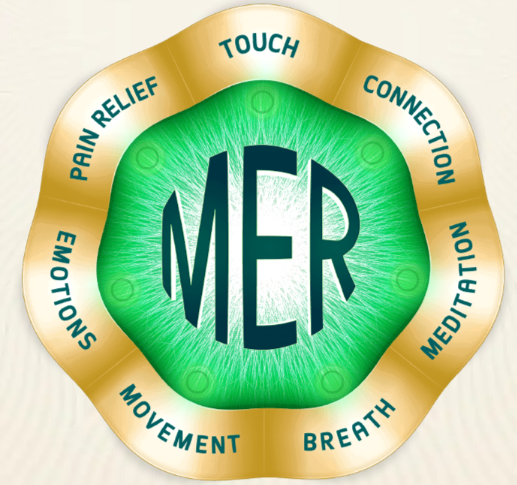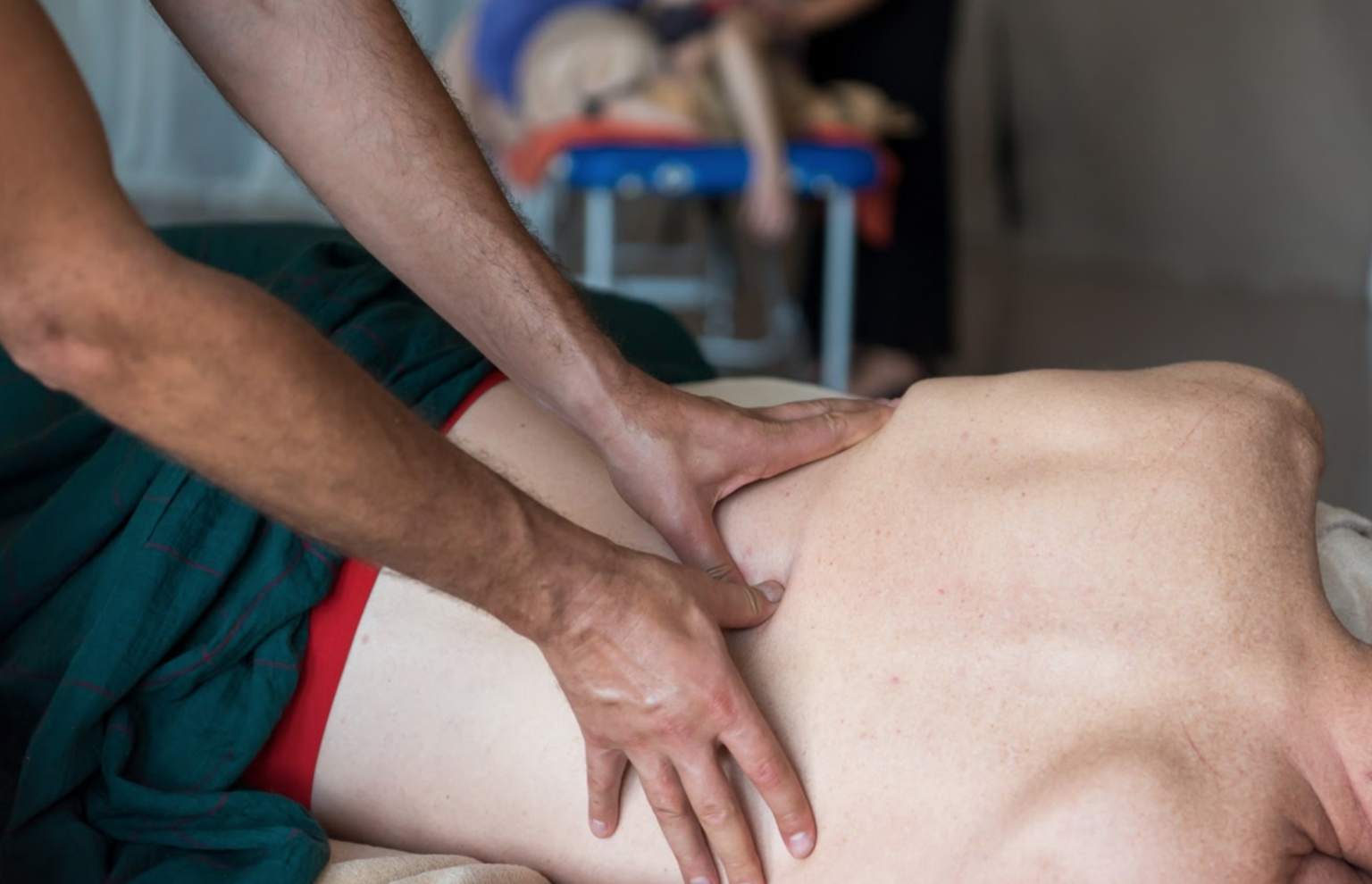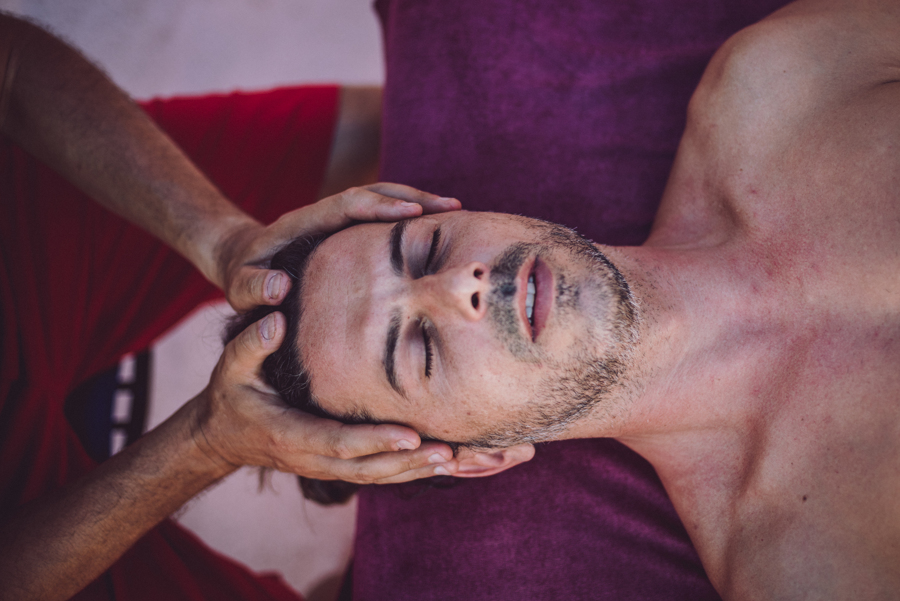
Myofascial Energetic Release (MER)
MER is an abbreviation of the English term Myofascial Energetic Release, which means myofascial energetic release. MER has evolved from OSHO Rebalancing Massage.
MER is a slow and meditative, yet deep and powerful form of bodywork. It alleviates acute and chronic physical pain while simultaneously treating the bodily expressions of emotional and mental pain. It is a combination of body reading, fascia manipulation, joint release, energy and breath work, body awareness training, and emotional expression. This approach is characterized by awareness, compassion, and meditation, which are central components of this therapy.
MER bodywork is deeply relaxing and therapeutic and consists of seven elements:
- Touch
- Connection
- Meditation
- Breathing
- Movement
- Emotions
- Pain relief


When can it help?
Symptom Reduction:
- Acute and chronic pain syndromes
- Dysfunction and deformation of connective tissues (fascia, tendons, ligaments)
- Spinal diseases (various curvatures, osteochondrosis)
- Consequences of injuries, fractures, old traumas
Supports:
- Body and mind balance
- Posture
- Stress reduction
- Joint mobility
- Blood circulation and energy flow in the body
- Sleep quality
- Mental clarity
- Deep relaxation
How does it work?
The main cause of muscle tension and pain is muscle overstrain or continuous work in a static position (overfatigue), which blocks blood circulation and thus the supply of oxygen to these soft and sensitive tissues, rich in nerve endings and pain receptors. Tense muscles and tendons press on nerve receptors, causing up to 90% of all chronic pain.
Pain is a protective sensation of the body, alerting it to harmful influences and causing a movement disorder if it persists. Without therapy, the pain cycle becomes self-generating and chronic.
All structures of the human body are surrounded, protected, and supported by connective tissue. Connective tissue forms a continuous network connecting all organs and muscles, while separating them and facilitating their mutual sliding. Tense connective tissue contains less fluid, becomes contracted, and shortened.
When connective tissue is influenced by proper contact and pressure, its biochemical properties change – the fluid becomes more fluid-like – allowing stretching and making the muscles and tendons more elastic.
The therapy technique is soft, smooth, and painless. It involves pressing, palpating, and soft stretching of the tissues.
Special sessions have been developed for the neck and back; back, legs, knees, and pelvic area; face, head, shoulders, and arms; chest and abdominal area, depending on the problem that bothers the person.
In the English video below, MER trainer Nisarga Eryk Dobosz talks about the technique in more detail.
Contraindications
- Hernia
- Disc problems
- Pregnancy over 6 weeks
- Osteoporosis
- Severe varicose veins
- Age under 15 years
- Pacemaker
- Rheumatism (joint degeneration)
- Schizophrenia and psychiatric problems (taking medications)
- Hospitalization
- Less than 6 months after surgery
- Stomach and intestinal ulcers
Useful to know
Before the Session
It is advisable not to eat 1.5 hours before the session.
After the Session
It is recommended to drink plenty of water to eliminate released toxins.
Recommendations
It is advisable to take this bodywork as a course, for example, once a week for a month or every other week for four times. The course helps achieve deeper results and solidify the achievements. However, the number of sessions depends individually on the person.
About connective tissue
Fascia, also known as connective tissue, has become a buzzword in recent years in holistic medicine, bodywork, and movement therapies. Research into the fascial system reveals intriguing dimensions of human anatomy, opening a gateway to connect body and mind with emotions, deepening and enriching our understanding of physical pain and its management. This natural interconnection of mind-body-emotion is central to many ancient healing practices.
There are three types of fascia:
- Superficial fascia: a layer of fat just beneath the skin.
- Deep fascia: a dense connective tissue layer that surrounds and penetrates individual muscles and muscle groups.
- Visceral fascia: a layer primarily found within the abdominal cavity.
In the context of bodywork, the deep fascia is of particular interest—the dense layer of connective tissue that envelops and permeates muscles, bones, nerves, and blood vessels throughout the body. This layer can be visualized as a continuous wrapping that literally covers all our internal body parts, providing structural support and a network.
The fascial system is fluid, and when functioning optimally, fascia is relaxed and elastic, allowing muscles to slide smoothly back and forth. The deep fascia is richly supplied with nerve endings that signal the presence of pain, movement, pressure, vibration, chemical changes, and temperature fluctuations. Therefore, the fascial system can be considered a secondary nervous system, transmitting energy and information from head to toe. This helps us understand why sometimes pain in one part of the body may spread seemingly randomly to other unrelated areas.
Fascial tissue can contract and relax independently of surrounding muscles, reacting to stress unbeknownst to us. Physical or emotional trauma, scarring, inflammation, restricted movement, overuse, and poor posture can all cause thickening of the connective tissue, making it less flexible and leading to movement restrictions, unhealthy holding patterns, and pain. One way to experience this effect is during our sleep, when fascia naturally thickens. Hence, we often feel less flexible in the morning and may feel compelled to stretch our bodies upon waking up. Over time, areas where fascia thickens may experience chronic pain and loss of mobility.
Fascia also responds to our emotional states and holds onto emotional memories. Eastern healing practices such as traditional Chinese medicine and acupuncture have long recognized this connection between body tissues and our emotions, and now there is growing scientific evidence that sadness, anxiety, pain, and past traumas can indeed be stored deep within the fascia. Healthy fascial tissue keeps the body upright, flexible, and free from pain.
Sources
myofascialtrainings.com/
sivaya.ee/teenus/sidekoemassaaz-mer-myofascal-energetic-relase-tehnikaga/
